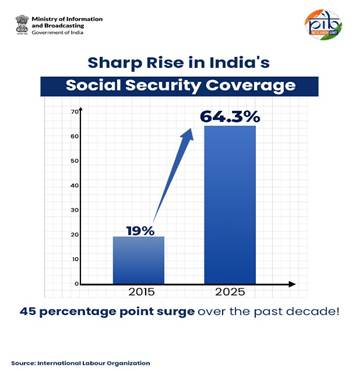India has achieved a remarkable milestone in social security, expanding coverage from 19% in 2015 to 64.3% in 2025, bringing over 94 crore people under at least one social protection benefit, according to the Press Information Bureau (PIB). This unprecedented 45-percentage-point increase over a decade, acknowledged by the International Labour Organization (ILO) on its ILOSTAT database, positions India as a global leader in social protection, second only to China in the number of beneficiaries.
Social security, as defined by the ILO, ensures access to healthcare and income security during times of old age, sickness, unemployment, disability, maternity, work injury, or loss of a breadwinner. India’s comprehensive system includes social insurance, welfare payments, and in-kind benefits like food and shelter security. The Ministry of Labour and Employment, in collaboration with the ILO, is conducting a national data pooling exercise using encrypted Aadhaar as a unique identifier across 34 major central schemes, such as MGNREGA, EPFO, ESIC, and PM-POSHAN. Launched on March 19, 2025, Phase I covers ten states, including Uttar Pradesh, Rajasthan, and Maharashtra, with plans to surpass 100 crore beneficiaries upon verification of additional schemes in Phase II.
This expansion is driven by the government’s pro-poor and labor welfare initiatives over the past 11 years, underpinned by simplified legislation and robust digital infrastructure. The codification of 29 labor laws into four Labour Codes—Wage Code, Social Security Code, Occupational Safety, Health and Working Conditions Code, and Industrial Relations Code—has extended protections to the unorganized sector, which constitutes nearly 90% of India’s 50 crore workers. The Social Security Code, 2020, ensures benefits like insurance, pension, gratuity, and maternity support, with contributions from employers and workers, and government funding for disadvantaged sections. Key provisions include expanding ESIC benefits to all sectors, establishing a social security fund for unorganized workers, and introducing a Universal Account Number (UAN) for seamless benefit portability.
Digital and financial inclusion has been pivotal. Over 55.64 crore Jan Dhan accounts as of June 18, 2025, have enabled direct benefit transfers, saving ₹3.48 lakh crore by March 2023. With 142 crore Aadhaar cards issued by June 27, 2025, and 5G connectivity reaching 99.6% of districts, digital access has become affordable and widespread, with data costs dropping from ₹308 per GB in 2014 to ₹9.34 in 2022.
Key schemes driving this transformation include the Pradhan Mantri Suraksha Bima Yojana (PMSBY), enrolling 51.06 crore people for accident insurance, and the Pradhan Mantri Jeevan Jyoti Bima Yojana (PMJJBY), covering 23.64 crore individuals with life insurance. The Pradhan Mantri Shram Yogi Maandhan Yojana (PM-SYM) provides pensions to 51.35 lakh unorganized workers, while the e-Shram portal has registered 30.91 crore workers, 53.77% of whom are women. The Atal Pension Yojana (APY) supports 7.25 crore subscribers, and the PM Vishwakarma Yojana has empowered 23.7 lakh artisans with loans and toolkits.
Women’s empowerment is a priority, with the Lakhpati Didi initiative aiming to transform 3 crore Self-Help Group women into high earners. The PM Ujjwala Yojana has provided over 10.33 crore free LPG connections, enhancing health and dignity. The Pradhan Mantri Awas Yojana (PMAY) has delivered nearly 4 crore houses, with 92.72 lakh urban homes and 2.77 crore rural homes, 25.29% registered to women.
Health and food security have also advanced. Ayushman Bharat has issued 41.29 crore health cards, offering up to ₹5 lakh in insurance, while the Ayushman Vay Vandana scheme extends coverage to seniors above 70. The Pradhan Mantri Garib Kalyan Anna Yojana (PMGKAY) has ensured food security for 80.67 crore people. For marginalized groups, the ADIP scheme has provided assistive devices to 31.16 lakh persons with disabilities over 11 years, and the SMILE scheme supports transgender individuals through 12 pilot Garima Greh shelter homes.










